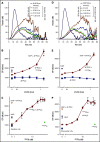An engineered factor Va prevents bleeding induced by direct-acting oral anticoagulants by different mechanisms
- PMID: 32777068
- PMCID: PMC7422119
- DOI: 10.1182/bloodadvances.2020001699
An engineered factor Va prevents bleeding induced by direct-acting oral anticoagulants by different mechanisms
Abstract
Control of bleeding with direct-acting oral anticoagulants (DOACs) remains an unmet clinical need. Activated superFactor V (superFVa) is an engineered activated protein C (APC)-resistant FVa variant with enhanced procoagulant activity resulting from an A2/A3 domain disulfide bond and was studied here for control of DOAC-induced bleeding. SuperFVa reversed bleeding induced by FXa inhibitors (rivaroxaban, apixaban), and the FIIa inhibitor dabigatran in BalbC mice. The blocking anti-protein C and APC [(A)PC] antibody SPC-54 also reduced FXa inhibitor induced bleeding similar to superFVa, whereas dabigatran-induced bleeding was not affected. This indicated that sufficient APC was generated to contribute to bleeding in the presence of FXa inhibitors, but not in the presence of dabigatran, suggesting that mechanisms contributing to bleeding differed for FXa and FIIa inhibitors. Despite different mechanisms contributing to bleeding, superFVa effectively reduced bleeding for all DOACs, indicating the versatility of superFVa's properties that contribute to its universal prohemostatic effects for DOAC associated bleeding. Supported by thrombin generation assays on endothelial cells in normal plasma spiked with DOACs and patient plasma anticoagulated with DOACs, 3 complementary mechanisms were identified by which superFVa achieved DOAC class-independent prohemostatic efficiency. These mechanisms are resistance to inactivation by APC, overcoming the FV activation threshold, and maximizing the efficiency of the prothrombinase complex when the available FXa is increased by FVIIa-based prohemostatics. In summary, it is this versatility of superFVa that delineates it from other prohemostatic agents as a promising class-independent rescue agent in bleeding situations associated with DOACs.
© 2020 by The American Society of Hematology.
Conflict of interest statement
Conflict-of-interest disclosure: A.v.D. has received honoraria for participating in scientific advisory board panels, consulting, and speaking engagements for Takeda, Biomarin, Bioverativ/Sanofi, Novo Nordisk, and Uniqure, and reports research support from Pfizer and Sanofi. The University of California San Diego and The Scripps Research Institute hold intellectual property rights related to superFVa on which A.v.D., A.J.G., J.H.G., and L.O.M. are listed as inventors. A.v.D., A.J.G., and L.O.M. are founders of Hematherix LLC, a biotech company that is developing superFVa therapy for bleeding complications. A.v.D. and L.O.M. are members of the board of directors of Hematherix LLC. The remaining authors declare no competing financial interests.
Figures







Similar articles
-
An engineered activated factor V for the prevention and treatment of acute traumatic coagulopathy and bleeding in mice.Blood Adv. 2022 Feb 8;6(3):959-969. doi: 10.1182/bloodadvances.2021005257. Blood Adv. 2022. PMID: 34861695 Free PMC article.
-
An engineered factor Va prevents bleeding induced by anticoagulant wt activated protein C.PLoS One. 2014 Aug 15;9(8):e104304. doi: 10.1371/journal.pone.0104304. eCollection 2014. PLoS One. 2014. PMID: 25127130 Free PMC article.
-
Current Strategies for the Management of Bleeding Associated with Direct Oral Anticoagulants and a Review of Investigational Reversal Agents.J Emerg Med. 2020 Feb;58(2):217-233. doi: 10.1016/j.jemermed.2019.10.011. Epub 2019 Dec 10. J Emerg Med. 2020. PMID: 31831187 Review.
-
The direct oral anticoagulants rivaroxaban and dabigatran do not inhibit orthotopic growth and metastasis of human breast cancer in mice.J Thromb Haemost. 2019 Jun;17(6):951-963. doi: 10.1111/jth.14443. Epub 2019 Apr 29. J Thromb Haemost. 2019. PMID: 30929299 Free PMC article.
-
Reversal agents for direct oral anticoagulants: considerations for hospital physicians and intensivists.Hosp Pract (1995). 2019 Aug;47(3):113-122. doi: 10.1080/21548331.2019.1643728. Epub 2019 Jul 29. Hosp Pract (1995). 2019. PMID: 31317796 Review.
Cited by
-
Distinct pleiotropic effects of direct oral anticoagulants on cultured endothelial cells: a comprehensive review.Front Pharmacol. 2023 Sep 29;14:1244098. doi: 10.3389/fphar.2023.1244098. eCollection 2023. Front Pharmacol. 2023. PMID: 37841935 Free PMC article. Review.
-
Blood Coagulation and Beyond: Position Paper from the Fourth Maastricht Consensus Conference on Thrombosis.Thromb Haemost. 2023 Aug;123(8):808-839. doi: 10.1055/a-2052-9175. Epub 2023 Mar 13. Thromb Haemost. 2023. PMID: 36913975 Free PMC article.
-
A small-molecule hemostatic agent for the reversal of direct oral anticoagulant-induced bleeding.Res Pract Thromb Haemost. 2024 Apr 27;8(4):102426. doi: 10.1016/j.rpth.2024.102426. eCollection 2024 May. Res Pract Thromb Haemost. 2024. PMID: 38882463 Free PMC article.
-
Effects of direct oral anticoagulants dabigatran and rivaroxaban on the blood coagulation function in rabbits.Open Life Sci. 2022 Jan 28;17(1):1-9. doi: 10.1515/biol-2022-0002. eCollection 2022. Open Life Sci. 2022. PMID: 35128064 Free PMC article.
-
An engineered activated factor V for the prevention and treatment of acute traumatic coagulopathy and bleeding in mice.Blood Adv. 2022 Feb 8;6(3):959-969. doi: 10.1182/bloodadvances.2021005257. Blood Adv. 2022. PMID: 34861695 Free PMC article.
References
-
- Ruff CT, Giugliano RP, Braunwald E, et al. . Comparison of the efficacy and safety of new oral anticoagulants with warfarin in patients with atrial fibrillation: a meta-analysis of randomised trials. Lancet. 2014;383(9921):955-962. - PubMed
-
- Lee CH, Fang CC, Tsai LM, et al. . Changing treatment patterns in patients with venous thromboembolism in Taiwan. Circ J. 2020;84(2):283-293. - PubMed
-
- Connolly SJ, Ezekowitz MD, Yusuf S, et al. ; RE-LY Steering Committee and Investigators . Dabigatran versus warfarin in patients with atrial fibrillation. N Engl J Med. 2009;361(12):1139-1151. - PubMed
-
- Connolly SJ, Eikelboom J, Joyner C, et al. ; AVERROES Steering Committee and Investigators . Apixaban in patients with atrial fibrillation. N Engl J Med. 2011;364(9):806-817. - PubMed

